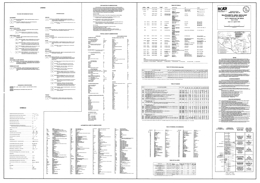| Publication Summary
|
| Issue ID: | OF1991-21 |
| Title: | Sulphurets Area Geology (parts of NTS 104A/5W, 12W; 104B/8E, 9E) |
| Author(s): | Alldrick, D.J., Britton, J.M. |
| Series Name: | Open File |
| Publication Year: | 1991 |
| Scale: | 1:20000 |
| NTS Map Sheet(s): | Parts of 104A/5W, 12W; 104B/8E, 9E |
| Place Keyword(s): | British Columbia, Northwestern British Columbia, Sulphurets Area |
| Lat/Long (NSWE): | 56.67, 56.294, -130.351, -129.937 |
| Theme Keyword(s): | Geology, Mineral Occurrences, Bedrock Geology |
| Download(s): | |
Abstract:  | Open File 1991-21 describes the geology and mineral occurrences of the Sulphurets area (104A, B) in northwestern British Columbia. The Open File consists of 5 sheets at 1:20 000 scale. Sheet 1 contains the legend and various tables, including mineral occurrences, assay data, whole rock analyses, potassium-argon ages and fossils. It also contains a schematic stratigraphic column, and brief notes. Sheet 2 to 5 are geological maps of the area. Results of mapping in adjacent areas are presented in Open Files 1990-16, 1990-19, 1989-10, 1988-4 and 1987-22. More than 60 mineral occurrences are known in the area. Six types of veins were identified: base metal quartz, silver-rich base metal, precious and base metal quartz, precious metal quartz, carbonate and barite. Other deposit types include: porphyry-style copper-molybdenum; disseminated gold (silver) in alternation zones; gold-bearing skarn; and stratabound pyritic zones. Deformation in the area is complex, with local folding and penetrative deformation, and many episodes of faulting associated with volcanic and intrusive activity. Biotite-rich quartzofeldspathic gneiss, phyllite, metawacke, metatuffs and marble are tentatively assigned to the Paleozoic Stikine or Asitka assemblage. They exhibit polyphase deformation. Mesozoic strata comprise mixed volcanic and volcanic-derived sedimentary rocks. Upper Triassic Stuhini Group strata are dominantly sediments with minor pyroxene phyric flows and tuffs, and leucocratic dacitic tuffs. The sediments are siltstones, pebble to cobble conglomerates and wackes. A Stuhini-Hazelton transitional unit of Hettangian age consists mainly of mixed sedimentary strata: black siltstones, heterolithic pebble to boulder conglomerates and wackes. Granitic stocks cut Stuhini Group rocks. The Sulphurets area is largely underlain by Lower to Middle Jurassic Hazelton Group volcanic and sedimentary rocks that have been folded, faulted and weakly metamorphosed, mainly during Cretaceous time. Three episodes of intrusive activity produced small synvolcanic plutons, satellitic stocks of the Coast plutonic complex and minor dykes and sills. The Unuk River Formation is of Hettangian to Pleinsbachian age. It consists primarily of andesitic tuffs with lesser black siltstone members. It is cut by the two-feldspar Premier porphyry. The Betty Creek Formation is Pleinsbachian to Toarcian. It consists of interbedded tuffs, flows and hematitic sedimentary rocks. There are locally pillowed basaltic to dacitic crystal and lithic tuffs and flows, purple to maroon conglomerates, wackes, siltstones and mudstones, and minor black siltstone layers. The Mount Dilworth Formation consists of felsic pyroclastics and flows. It consists of tuff breccias; lapilli, ash and dust tuffs; and local welded ash flows. The unit is of Toarcian age. Salmon River Formation, which is Toarcian to Bajocian in age, comprises a thick turbidite succession. It consists of black siltstones with lesser sandstones and minor limestone lenses. Intrusive rocks are not abundant but are spatially and temporally associated with mineralization. The Lee Brant stock, a Jurassic (?) quartz monzonite, comprises the largest intrusion in the area. A wide variety of syn and post-volcanic hypabyssal stocks is concentrated near the Sulphurets and Mitchell glaciers. Most are quartz-poor and have alkaline affiliations; many are porphyritic with potassium, feldspar, hornblende and biotite. These intrusions are similar in composition to the volcanic rocks. Post-volcanic intrusions are generally more phaneritic and clearly cut the country rocks. Compositions differ from enclosing rocks and some are associated with copper and gold mineralization. More than 60 mineral occurrences are known in the area. Six types of veins are identified: base metal quartz, silver-rich base metal, precious and base metal quartz, precious metal quartz, carbonate, and barite. Other deposit types include: porphyry-style copper-molybdenum; disseminated gold (silver) in alteration zones; gold-bearing skarn; and stratabound pyritic zones. Deformation in the area is complex, with local folding and penetrative deformation, and many episodes of faulting associated with volcanic and intrusive activity. |





